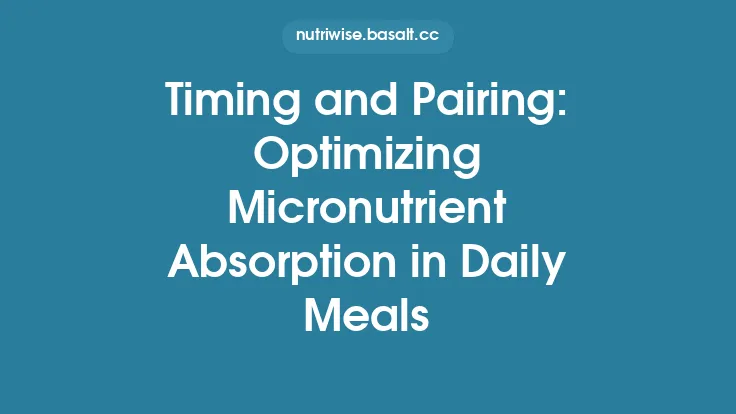Stir‑frying is often celebrated for its speed, flavor, and the way it brings a vibrant medley of vegetables, proteins, and aromatics together in a single pan. Yet, beyond the sizzling spectacle lies an opportunity to turn this high‑energy technique into a practice of mindfulness. By paying close attention to the heat that courses through the wok, the precise timing of each ingredient, and the subtle cues your body offers, you can transform a routine dinner into a calming, present‑moment experience. This article explores the mechanics of stir‑fry, the mental habits that support a focused mind, and practical steps to weave presence into every flash‑cooked bite.
Understanding the Fundamentals of Stir‑Fry Heat
1. The physics of a wok
A traditional carbon‑steel wok is prized for its thin walls and rounded bottom, which promote rapid heat transfer. When placed over a high‑output burner, the metal quickly reaches temperatures between 200 °C and 260 °C (390 °F–500 °F). At these levels, the surface energy is sufficient to trigger the Maillard reaction—a complex series of chemical changes that create the deep, caramelized flavors characteristic of a good stir‑fry.
2. Smoke point and oil selection
Choosing an oil with a high smoke point (e.g., refined avocado, grapeseed, or peanut oil) ensures that the oil remains stable at wok temperatures, preventing unwanted off‑flavors and excessive smoke. The smoke point is the temperature at which oil begins to break down and release volatile compounds; staying below this threshold preserves both taste and the kitchen’s air quality, which contributes to a calmer environment.
3. Pre‑heating and temperature cues
Before adding any ingredients, the wok should be heated until a few drops of water evaporate instantly upon contact—a phenomenon known as “the dance of droplets.” This visual cue signals that the surface is uniformly hot. For a mindful practitioner, watching this transformation can serve as a grounding moment, anchoring attention to the present.
4. Heat modulation
Even though stir‑frying is a high‑heat method, the ability to modulate temperature is essential. After the initial sear, reducing the flame slightly prevents burning while still maintaining enough heat for rapid cooking. Practicing subtle adjustments—raising or lowering the burner by a fraction—cultivates a tactile awareness that mirrors the fine motor control used in meditation.
The Rhythm of Timing: Sequencing Ingredients for Balance
1. The “hard‑soft” hierarchy
Ingredients differ in density, moisture content, and cooking time. A reliable sequence follows the “hard‑soft” rule: start with the densest, least moist items (e.g., carrots, broccoli stems, firm tofu) and finish with the most delicate (e.g., leafy greens, herbs). This ordering ensures each component reaches optimal doneness without overcooking the next.
2. The “one‑minute rule”
Because the wok’s heat is intense, most ingredients require only 30–90 seconds of contact. Setting a mental timer—whether a subtle glance at a watch or a silent count of breaths—helps maintain the rapid rhythm without rushing. The brief interval also encourages the cook to stay fully engaged, as any lapse can quickly lead to burnt edges or soggy vegetables.
3. Layered aromatics
Aromatics such as garlic, ginger, and chilies release their volatile oils at different stages. Adding them in layers—first the aromatics that need a quick flash (e.g., sliced ginger), then those that benefit from a slightly longer exposure (e.g., minced garlic)—creates depth of flavor while keeping the mind attuned to the evolving scent profile.
4. Sauce integration
Sauces are typically introduced after the main ingredients have been turned and are near completion. A thin slurry of soy sauce, rice vinegar, and a touch of cornstarch can be poured in, then quickly tossed to coat. The moment the sauce hits the hot wok, it thickens almost instantly; observing this transformation reinforces the sense of cause and effect, a core principle of mindful awareness.
Cultivating Presence: Mindful Attention in the Hot Wok
1. Anchoring to the senses
While the article on “Sensory Awareness in Cooking” explores broader sensory practice, within stir‑fry the focus narrows to three primary cues: sound, sight, and touch.
- Sound: The sizzle is a metronome. Each pop of a vegetable hitting the oil signals a beat. By aligning your breath with the rhythm—inhale on the first sizzle, exhale on the second—you create a subtle, natural flow.
- Sight: The color shift from raw to lightly caramelized is a visual marker of progress. Notice the transition from bright green to a deeper, glossy hue.
- Touch: The weight of the wok handle, the resistance of the spatula against the hot surface, and the slight vibration of the pan convey information about temperature and momentum.
2. Micro‑pauses
Between rapid tosses, allow a brief micro‑pause—just a fraction of a second—to observe the current state of the ingredients. This pause is not a delay but a moment of conscious registration, preventing the mind from slipping into autopilot.
3. Intentional movement
When flipping or stirring, engage the whole body: rotate the wrist, shift the weight of the forearm, and use a smooth, circular motion. This coordinated movement mirrors the flow state often described in sports psychology, where action and awareness merge seamlessly.
4. Emotional labeling
If frustration arises (e.g., a piece sticks or the oil smokes), silently label the feeling—“I’m feeling impatient.” Naming the emotion creates a mental distance, allowing you to respond rather than react, thereby preserving calm.
Tools and Environment that Support a Calm Stir‑Fry
1. Wok selection and maintenance
A well‑seasoned carbon‑steel wok develops a natural non‑stick patina, reducing the need for excess oil and minimizing sticking. Regular seasoning—heating the wok, wiping with a thin layer of high‑smoke‑point oil, and allowing it to cool—creates a reliable cooking surface that behaves predictably, which in turn reduces mental friction.
2. Spatula choice
A stainless‑steel or bamboo spatula with a slightly curved edge offers precise control. The tactile feedback from a sturdy handle helps maintain a steady rhythm.
3. Kitchen layout
Arrange all pre‑pped ingredients within arm’s reach before heating the wok. This “mise en place” eliminates unnecessary movement, allowing the mind to stay centered on the cooking process rather than searching for tools.
4. Ventilation
A functional range hood set to an appropriate fan speed ensures that smoke does not accumulate, preserving air quality and preventing the irritation that can disrupt focus.
5. Ambient elements
Soft background music with a steady tempo (e.g., instrumental or ambient) can reinforce the rhythmic nature of stir‑frying without becoming a distraction. The key is to keep the auditory environment supportive rather than demanding.
Integrating Breath and Movement without Formal Techniques
While dedicated breathing exercises belong to other articles, a subtle, natural alignment of breath with cooking actions can be woven into stir‑fry effortlessly.
- Inhale as you add oil and hear the initial hiss.
- Exhale as you introduce the first batch of hard vegetables, feeling the heat radiate.
- Inhale when you toss the aromatics, noticing the fragrant plume.
- Exhale as you drizzle the sauce, watching it swirl and thicken.
This pattern does not require a separate meditation; it simply uses the natural pauses in the cooking sequence to keep the breath steady, which in turn steadies the mind.
Common Pitfalls and How Mindful Adjustments Prevent Them
| Pitfall | Mindful Indicator | Adjustment |
|---|---|---|
| Oil overheating and smoking | Visual cue: thin, blue‑gray smoke; auditory cue: harsh crackle | Reduce flame immediately; step back and observe the oil’s surface before adding ingredients |
| Overcrowding the wok | Sensory cue: loss of sizzle, steam pooling | Pause, remove a portion of ingredients, and let the wok regain its high heat before returning them |
| Uneven cooking of vegetables | Visual cue: some pieces remain bright while others darken | Use the “hard‑soft” hierarchy; if a piece is lagging, give it a brief extra toss or push it to the edge of the wok where heat is slightly lower |
| Loss of focus due to multitasking | Mental cue: wandering thoughts about unrelated tasks | Gently bring attention back to the present by naming the distraction (“thinking about email”) and refocusing on the sizzle |
| Burnt aromatics | Olfactory cue: bitter, acrid smell | Remove aromatics quickly, add a splash of liquid (water, broth) to deglaze, and continue cooking the main ingredients |
By treating each warning sign as a moment for mindful recalibration, the cook maintains both culinary quality and mental composure.
Creating a Personal Stir‑Fry Practice for Ongoing Calm
- Set an intention (brief, not elaborate) – Before lighting the burner, state a simple purpose such as “I will stay present with each toss.” This brief mental note frames the session without becoming a separate ritual.
- Develop a signature rhythm – Choose a consistent tempo for stirring (e.g., one toss every two seconds). Over time, this rhythm becomes a personal mantra, reinforcing steadiness.
- Reflect post‑cook – After plating, take a moment to notice the aroma, texture, and color of the dish. A quick mental scan of what went well and what could be refined consolidates learning and deepens the mindful habit.
- Iterate with variations – Experiment with different protein sources, vegetable combos, or spice levels, but keep the core mindful framework unchanged. This balance of novelty and consistency sustains engagement without overwhelming the mind.
- Document observations – A small kitchen journal can capture brief notes: “Noticed oil smoked at 240 °C; lowered flame earlier next time.” This practical record supports continuous improvement while reinforcing the mindful mindset.
Conclusion: The Ongoing Journey of Heat, Timing, and Presence
Stir‑frying, at its core, is a dance of fire, motion, and flavor. By treating the wok as a focal point for attention, respecting the physics of heat, and honoring the precise timing each ingredient demands, the cook can cultivate a state of calm concentration that endures beyond the kitchen. The practice does not require elaborate rituals; it thrives on the everyday moments of sizzle, color change, and breath that accompany a well‑executed stir‑fry. As you continue to refine your technique, you’ll discover that the balance of heat, timing, and presence not only yields delicious meals but also nurtures a resilient, mindful mind—ready to meet the fast‑paced rhythm of modern life with poise and flavor.





